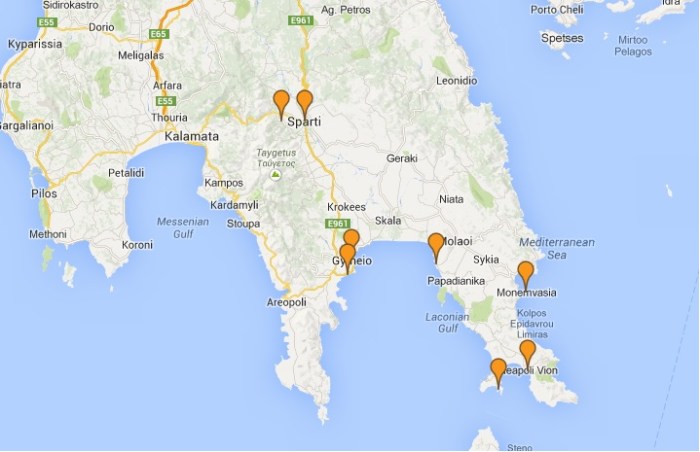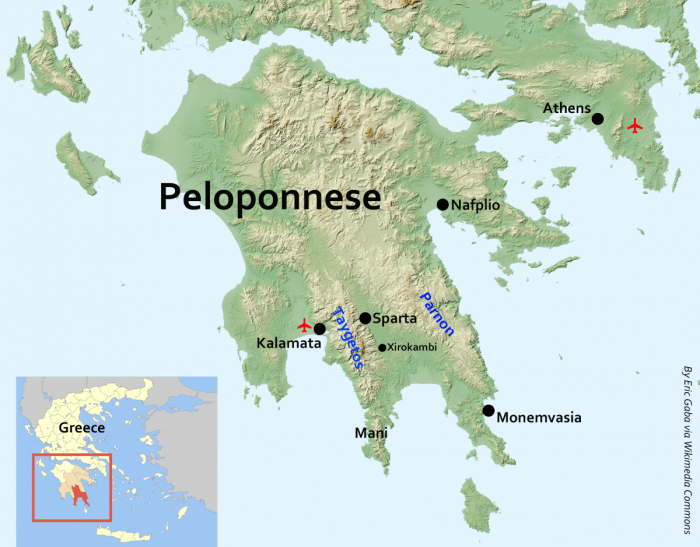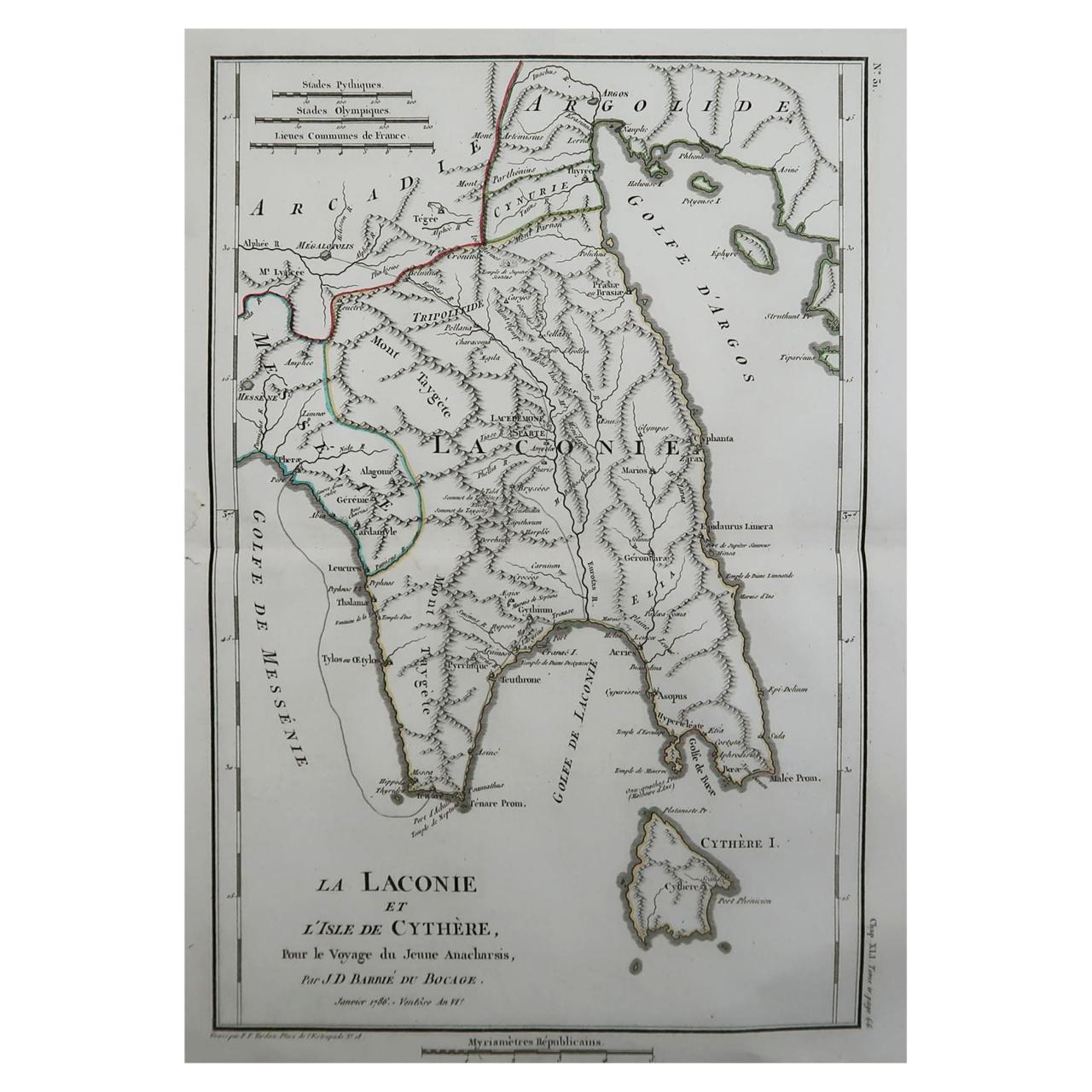Map of ancient greece laconia – Embark on a journey through the ancient lands of Greece, where history unfolds in the map of Laconia. This region, etched into the annals of time, played a pivotal role in shaping the destiny of the Hellenic world.
Laconia’s geographical location, nestled in the southern Peloponnese, made it a strategic gateway to the Aegean Sea. It was here that the legendary city of Sparta emerged, leaving an enduring legacy that continues to resonate today.
Geographic Overview

Laconia, a prominent region in ancient Greece, was located in the southeastern part of the Peloponnese peninsula. This region, bordered by Messenia to the west and Argolis to the northeast, held great significance throughout Greek history.
Laconia’s strategic position and fertile lands made it a desirable territory. Its influence extended beyond its geographical boundaries, as it played a pivotal role in the development of ancient Greek culture and politics.
Geographic Significance, Map of ancient greece laconia
- Laconia’s geographical location, nestled between the Taygetus Mountains and the Laconian Gulf, provided both protection and access to the sea.
- The region’s fertile plains and valleys supported a prosperous agricultural economy, contributing to its wealth and influence.
- Laconia’s proximity to major trade routes and ports made it a hub for commerce and cultural exchange.
Key Cities and Landmarks

Laconia, a region in ancient Greece, boasts a rich tapestry of cities and landmarks that played pivotal roles in shaping its history and culture.
Sparta
Sparta, the formidable city-state, was the heart of Laconia. Renowned for its rigorous military training and disciplined society, Sparta dominated the Peloponnese for centuries. The ruins of its ancient fortifications, including the Acropolis and the Sanctuary of Artemis Orthia, stand as testaments to its military prowess and religious devotion.
Other Major Cities
Beyond Sparta, Laconia was home to other notable cities. Gytheion, a coastal town, served as a major port and naval base. Sellasia, located in a strategic pass, was the site of a decisive battle between Sparta and the Macedonian Empire.
Therapne, a sacred city, was home to the Temple of Menelaion, dedicated to the legendary Spartan king.
Landmarks
In addition to its cities, Laconia is dotted with significant landmarks. Mount Taygetos, a towering mountain range, provided a natural border and a source of timber for shipbuilding. The Eurotas River, flowing through the region, was a vital resource for irrigation and transportation.
The Menelaion, a circular temple, was believed to be the burial place of King Menelaus and Helen of Troy.
Spartan Civilization
The rise of Sparta in Laconia began around the 10th century BCE. The Spartans developed a unique social, political, and military system that enabled them to become one of the most powerful city-states in ancient Greece.
Spartan society was divided into three classes: the Spartiates (full citizens), the Perioeci (non-citizens who lived in the surrounding countryside), and the Helots (slaves). The Spartiates were the warrior class and were responsible for defending the city-state. They were trained from a young age in the art of war and were expected to be loyal to Sparta above all else.
The Spartan government was an oligarchy, ruled by a council of elders and two kings. The kings were responsible for leading the army in battle, while the council of elders made laws and oversaw the administration of the city-state.
The Spartan military was one of the most formidable in ancient Greece. The Spartans used a unique formation called the phalanx, which was a dense formation of hoplites (heavily armed infantrymen). The phalanx was nearly invincible in battle, and it helped Sparta to win many victories against its enemies.
Spartan Social System
The Spartan social system was designed to produce strong and disciplined warriors. Boys were taken from their families at the age of seven and placed in military training camps. They were subjected to a rigorous regimen of physical and mental training, and they were taught to obey orders without question.
Girls were also educated in Sparta, but their education was focused on preparing them for their roles as wives and mothers. They were taught to be strong and self-sufficient, and they were expected to produce healthy children who would grow up to be strong warriors.
Spartan Political System
The Spartan political system was designed to ensure the stability of the state. The two kings ruled jointly, and they were advised by a council of elders. The council of elders was made up of 28 men who were over the age of 60. They were elected by the Assembly, which was made up of all Spartan citizens.
The Assembly had the power to make laws, declare war, and elect officials. However, the Assembly was not a democratic institution. The kings and the council of elders had the final say on all matters, and they could override the decisions of the Assembly if they wished.
Spartan Military System
The Spartan military system was designed to produce a well-trained and disciplined army. The Spartans used a unique formation called the phalanx, which was a dense formation of hoplites (heavily armed infantrymen). The phalanx was nearly invincible in battle, and it helped Sparta to win many victories against its enemies.
The Spartans were also skilled in siege warfare. They developed a number of siege engines, including the battering ram and the siege tower. These engines allowed the Spartans to breach enemy walls and capture their cities.
Artistic and Cultural Heritage

Laconia’s artistic and cultural achievements played a significant role in shaping the cultural landscape of ancient Greece. Laconia was renowned for its exquisite pottery, impressive sculptures, and distinct architectural style.
The region’s potters were renowned for their mastery in producing intricate and highly decorated ceramics. Laconian pottery was characterized by its black-figure and red-figure techniques, which depicted scenes from mythology, daily life, and historical events.
Pottery
- Laconia’s pottery was highly sought after throughout the Greek world and beyond.
- It featured intricate designs and motifs, often depicting scenes from Greek mythology.
- Laconian potters were particularly skilled in the black-figure and red-figure techniques.
Laconia’s sculptors also made significant contributions to Greek art. The region was known for its monumental bronze statues, particularly those depicting warriors and athletes. The most famous example is the “Leonidas of Sparta” statue, which commemorates the legendary Spartan king who led the defense of Thermopylae against the Persian army.
Sculpture
- Laconia’s sculptors were renowned for their bronze statues, particularly those depicting warriors and athletes.
- The “Leonidas of Sparta” statue is a famous example of Laconian sculpture.
- Laconia’s sculptures were characterized by their realism and attention to detail.
In architecture, Laconia developed a distinctive style that emphasized simplicity and functionality. Laconian buildings were typically constructed of stone and featured clean lines and minimal ornamentation. The most famous example of Laconian architecture is the Sanctuary of Artemis Orthia, which was a major religious center in ancient Sparta.
Architecture
- Laconia’s architecture was characterized by its simplicity and functionality.
- Laconian buildings were typically constructed of stone and featured clean lines and minimal ornamentation.
- The Sanctuary of Artemis Orthia is a famous example of Laconian architecture.
Laconia’s artistic and cultural achievements had a profound influence on the wider Greek world. Laconian pottery, sculpture, and architecture were widely imitated and admired, and they played a key role in the development of Greek art and culture.
Archaeological Discoveries

Laconia has been a rich source of archaeological discoveries, shedding light on ancient Greek history and culture. Excavations have uncovered significant remains that provide valuable insights into the region’s past.
One of the most notable discoveries is the Palace of Nestor in Pylos. Excavated in the 1930s, the palace dates back to the Mycenaean period (1600-1100 BCE) and is considered one of the best-preserved examples of Mycenaean architecture. The palace complex features a large central courtyard, storerooms, workshops, and living quarters, providing a glimpse into the daily life and administrative practices of the Mycenaean elite.
Linear B Tablets
The Palace of Nestor is also famous for the discovery of Linear B tablets, a written script used by the Mycenaeans. These tablets contain administrative records and provide valuable information about the economic and social organization of the Mycenaean kingdom.
The decipherment of Linear B in the 1950s revolutionized our understanding of the Mycenaean civilization and confirmed the existence of a written language in ancient Greece before the development of the Greek alphabet.
Mycenaean Tombs
In addition to the Palace of Nestor, numerous Mycenaean tombs have been discovered in Laconia. These tombs, often decorated with elaborate frescoes and containing rich grave goods, provide insights into the funerary practices and beliefs of the Mycenaeans. One of the most famous Mycenaean tombs is the Tomb of Clytemnestra, located near Mycenae.
The tomb contains a large burial chamber with a domed roof and is believed to have been the burial place of Clytemnestra, the wife of Agamemnon, the legendary king of Mycenae.
If you’re exploring the fascinating map of ancient Greece, don’t miss the region of Laconia. This area is renowned for its rich history and captivating stories. For a deeper dive into the local lore, check out the juniper tree summary pdf . This comprehensive guide provides insights into the enigmatic legends and folklore that have shaped Laconia’s identity.
As you delve into the map of ancient Greece, Laconia remains a captivating destination, where the past whispers secrets through its timeless ruins and enduring tales.
Historical Significance
Beyond the prominence of Spartan civilization, Laconia played a pivotal role in shaping the historical narrative of ancient Greece. Its strategic location and natural resources made it a significant player in regional and pan-Hellenic affairs.
Laconia’s fertile plains and abundant forests provided sustenance and wealth, contributing to its economic prosperity. Its rugged terrain and access to the sea offered both defensive advantages and opportunities for maritime expansion.
Laconia in Major Events and Conflicts
- Peloponnesian War:Laconia was the heartland of Sparta, which led the Peloponnesian League against Athens in this protracted conflict.
- Persian Wars:Lacedaemonians (Spartans) fought valiantly at the Battle of Thermopylae, delaying the Persian advance into Greece.
- Theban-Spartan War:Laconia was the battleground for this conflict between Sparta and Thebes, which weakened both city-states and paved the way for Macedonia’s rise.
Modern Influence: Map Of Ancient Greece Laconia
Laconia’s ancient history and culture continue to exert a profound influence on modern society, shaping our understanding of warfare, politics, and the arts.
The legacy of the Spartans, renowned for their military prowess and austere lifestyle, has inspired generations of thinkers and soldiers. Their emphasis on discipline, loyalty, and physical fitness remains a cornerstone of military training worldwide.
Cultural Heritage
Laconia’s artistic and cultural achievements have also left an enduring mark on Western civilization. The region’s ancient temples, sculptures, and pottery continue to be admired and studied by scholars and artists alike.
Political Thought
The political system developed by the Spartans, based on a dual monarchy and a citizen assembly, has influenced political thought throughout history. The idea of a mixed government, balancing the powers of different branches, can be traced back to Laconia.
Military Strategy
The Spartans’ military tactics, particularly their use of the phalanx formation, have been studied and emulated by military strategists for centuries. The phalanx’s emphasis on discipline, coordination, and heavy armor proved effective against a wide range of enemies.
Essential Questionnaire
What was the significance of Laconia in ancient Greece?
Laconia was home to Sparta, one of the most powerful and influential city-states in ancient Greece, known for its military prowess and unique social and political systems.
What are some of the key landmarks in Laconia?
Besides Sparta, Laconia boasts other notable landmarks such as the ruins of the ancient city of Mystras, the medieval fortress of Monemvasia, and the scenic Mani Peninsula.
What are some of the artistic and cultural achievements of Laconia?
Laconia was renowned for its pottery, sculpture, and architecture, with notable examples including the Amyclaean Throne and the Temple of Apollo at Amyclae.